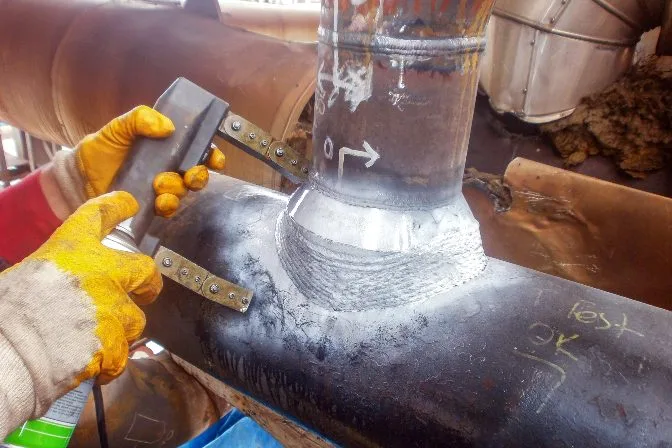Comprehensive Guide to Effective Container Welding Assessment Techniques and Finest Practices for Quality Assurance
In the world of storage tank welding, rigorous inspection strategies are paramount for guarding architectural integrity and guaranteeing conformity with market laws. As we check out these vital components, it comes to be clear that a positive examination strategy is not simply beneficial, yet important for functional success in environments dealing with hazardous products.
Importance of Tank Welding Inspection

Container welding inspection functions as a preventative procedure, recognizing potential problems such as fractures, porosity, or inappropriate joint infiltration prior to they intensify into serious problems. Normal assessments not only comply with industry laws and standards however additionally boost the durability of the storage tanks, minimizing the requirement for expensive repairs or substitutes.

Visual Evaluation Techniques
Using systematic aesthetic assessment methods is crucial for assessing the high quality and stability of bonded joints in tanks. This technique offers as the very first line of protection in recognizing possible flaws such as cracks, damages, and not enough penetration. The inspector needs to approach the task with an eager eye, utilizing proper devices like magnifying glasses, flashlights, and mirrors to improve presence.
Throughout the evaluation process, the assessor ought to evaluate the weld account, guaranteeing it sticks to specified criteria and standards (Tank Welding Inspection). This includes taking a look at the bead size, height, and blend with the base product. Assessors ought to additionally pay attention to the bordering areas for indicators of thermal distortion or contamination that may impact the weld's efficiency
Documents of searchings for is important; assessors need to videotape any type of abnormalities, classifying them by severity for further assessment. This organized technique not just aids in instant problem recognition however additionally adds to lasting quality control by making sure conformity with market requirements. Regular training and calibration of aesthetic inspection strategies better improve the dependability of assessments, eventually causing much safer and a lot more long lasting storage tank frameworks.
Non-Destructive Checking Approaches
Non-destructive screening (NDT) techniques are regularly employed in container welding examinations to examine the integrity of welded joints without endangering their architectural integrity. These methods are essential for determining issues such as cracks, spaces, and incorporations that could bring about catastrophic failings if left unseen.
Common NDT techniques consist of ultrasonic testing (UT), which uses high-frequency audio waves to detect interior imperfections; radiographic testing (RT), employing X-rays or gamma rays to picture weld frameworks; and magnetic bit testing (MT), which exposes surface area and near-surface suspensions in ferromagnetic products (Tank Welding Inspection). Fluid penetrant screening (PT) is also widely utilized, qualified of identifying surface-breaking defects by applying a fluorescent or color contrast dye
Each NDT method has its details applications and benefits, making it necessary for examiners to select the proper technique based upon the product and the kind of weld being evaluated. The combination of these NDT techniques into the assessment process improves the general quality control framework, ensuring that bonded tanks meet security and performance standards. Inevitably, NDT plays a crucial role in keeping the honesty and durability of container frameworks in different industrial applications.

Documentation and Reporting
Making sure complete documents and coverage throughout container welding examinations is essential for keeping compliance with industry requirements and assisting in efficient communication among stakeholders. Correct documents functions as a comprehensive document of inspection tasks, searchings for, and any type of restorative actions taken throughout the welding procedure. This details is essential not just for quality control yet likewise for audits and regulative evaluations.

A well-structured inspection record must include information such as the date of evaluation, names of examiners, welding procedures employed, materials made redirected here use of, and any kind of inconsistencies from established standards. Additionally, photographs and layouts can enhance the clarity of the record, supplying visual context to the searchings for. It is likewise essential to document any kind of non-conformities together with their resolution, ensuring that all stakeholders are educated of prospective threats and straight from the source the steps taken to minimize them.
Moreover, maintaining a central data source for all evaluation records enables for simple access and evaluation, promoting a society of transparency and responsibility. By focusing on precise documents and coverage, organizations can not only maintain quality guarantee but additionally strengthen their online reputation within the industry, ultimately causing enhanced security and functional effectiveness.
Continual Improvement Practices
Constant renovation techniques are crucial for boosting the high quality and efficiency of tank welding examinations. One reliable method includes regular training and upskilling of inspection employees to remain abreast of the most current welding innovations and requirements.
Furthermore, using data-driven analysis allows companies to track assessment results, determine trends, and identify locations for improvement. Using devices such as origin evaluation can aid in understanding the underlying issues causing problems, enabling targeted treatments. Furthermore, soliciting feedback from examination teams and stakeholders creates a joint atmosphere that encourages cutting-edge options.
Incorporating innovative innovations, such as computerized examination systems and real-time tracking, can considerably boost the accuracy and rate of assessments. Regular audits of the examination processes also contribute to a culture of liability and continual refinement. Eventually, these continuous renovation techniques not only raise the quality of storage tank welding inspections however also add to total operational quality and customer complete satisfaction.
Verdict
In final thought, reliable storage tank welding evaluation is go crucial for guaranteeing the structural stability and security of storage systems, specifically those handling harmful materials. Using a mix of visual evaluation methods and non-destructive testing methods promotes the very early identification of defects, thereby maintaining conformity with industry requirements.
Comments on “Why Normal Tank Welding Inspection is Crucial for Architectural Integrity”